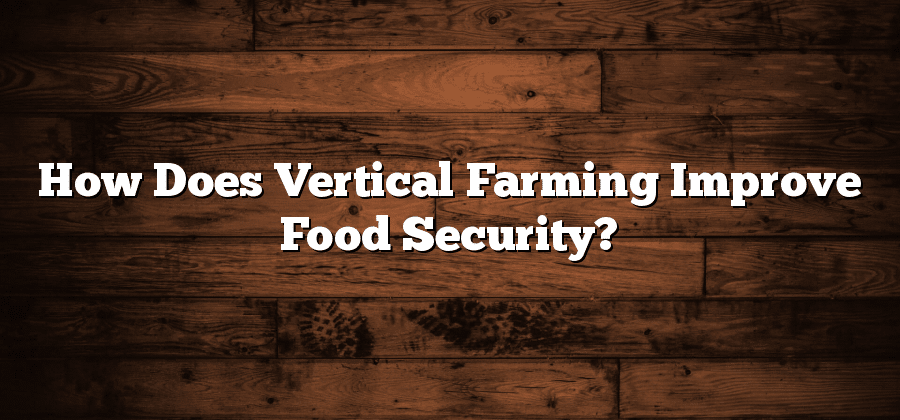Definition of Vertical Farming
Vertical farming is a modern agricultural practice that involves growing crops in vertically stacked layers or racks. This innovative approach maximizes the use of urban space, allowing for more efficient and productive cultivation of crops. Unlike traditional agriculture, which relies on expansive fields and variable weather conditions, vertical farming utilizes controlled environments such as indoor warehouses or high-rise buildings to create optimal conditions for plant growth.
In a vertical farm, artificial lighting, hydroponic systems, and other advanced technologies are employed to provide plants with the necessary light, nutrients, and water. This eliminates the dependence on natural sunlight, soil quality, and seasonal variations, allowing for year-round production of various crops. By stacking plants vertically, vertical farming optimizes space utilization, enabling higher yields per square meter compared to traditional farming methods. This approach not only boosts crop productivity but also supports sustainable urban development by reducing the need to convert valuable land into agricultural spaces.
Benefits of Vertical Farming for Food Security
Vertical farming offers numerous benefits for enhancing food security in both urban and rural areas. Firstly, vertical farming allows for year-round crop production, irrespective of weather conditions or seasonal limitations. With the use of controlled environments and artificial lighting, crops can be grown in a consistent and predictable manner, ensuring a stable food supply throughout the year. This can help reduce the vulnerability of communities to external disruptions such as natural disasters or climate change.
Secondly, vertical farming maximizes the use of limited space, making it possible to grow more crops in smaller areas. By utilizing vertical space, multiple levels of crops can be cultivated, increasing overall productivity. This is especially significant in densely populated urban areas where land availability is scarce. Vertical farming can effectively transform vacant buildings and abandoned warehouses into productive agricultural spaces, reducing the reliance on traditional farmlands and allowing urban communities to produce their own fresh and nutritious food.
Increased Crop Yield through Vertical Farming
Vertical farming offers a promising solution to the challenge of increasing crop yield to meet the growing demand for food. By utilizing advanced indoor cultivation techniques, such as hydroponics and aeroponics, vertical farming allows for a controlled environment where crops are grown in vertically stacked layers. This space-efficient system optimizes the use of resources, ensuring that every inch of the vertical farm is utilized effectively. The result is a significant increase in crop yield compared to traditional agriculture methods.
One of the primary reasons for the increased crop yield in vertical farming is the ability to provide optimal growing conditions for plants. By closely monitoring and adjusting factors like temperature, humidity, and nutrient levels, vertical farms create an ideal environment for plant growth throughout the year. This eliminates the variability often associated with outdoor agriculture, where crops are exposed to unpredictable weather conditions and pests. As a result, plants in vertical farms experience accelerated growth and higher production rates, leading to a significant increase in crop yield. Additionally, vertical farming allows for year-round cultivation, further contributing to the enhanced crop output compared to seasonal traditional farming.
Reduced Dependence on Traditional Agriculture
With the advent of vertical farming, the reliance on traditional agriculture is being greatly reduced. Traditionally, farming has been dependent on vast expanses of land and favorable weather conditions. However, vertical farming eliminates these constraints by growing crops indoors, in specially designed structures. This means that agricultural activities are no longer limited to specific geographical locations or seasons, offering greater independence from the uncertainties associated with traditional farming.
Moreover, vertical farming techniques allow for year-round cultivation, enabling a consistent supply of fresh produce regardless of seasonal variations. By utilizing advanced technologies such as LED lighting and automated nutrient delivery systems, vertical farms can create optimized growing conditions that boost crop yields. This increased productivity not only helps meet the growing demand for food but also reduces the need to rely heavily on traditional agricultural practices. As a result, vertical farming holds great promise in ensuring a more sustainable and self-reliant future for the food industry.
Minimizing Environmental Impact through Vertical Farming
Vertical farming is a sustainable agricultural practice that holds great promise in minimizing environmental impact. One of the ways in which vertical farming achieves this is through the efficient use of resources. With the use of advanced technologies such as LED lighting and hydroponics, vertical farms are able to provide the optimal conditions for plant growth while using significantly less water and energy compared to traditional farming methods. This not only reduces the strain on natural resources but also mitigates the risks of soil erosion and water pollution that can occur in conventional farming.
Furthermore, vertical farming can help to limit the use of harmful pesticides and herbicides. By cultivating crops in controlled indoor environments, vertical farms are less susceptible to pests and diseases, reducing the need for chemical interventions. Additionally, the closed-loop systems of vertical farms allow for the recycling and reuse of water, which further minimizes the release of harmful agricultural runoff into ecosystems. Overall, through its resource-efficient practices and reduced reliance on chemical inputs, vertical farming presents a promising solution for minimizing the environmental impact of food production.






